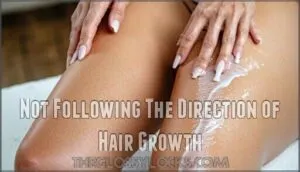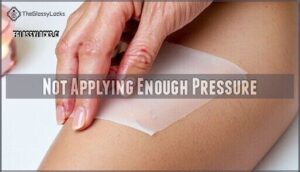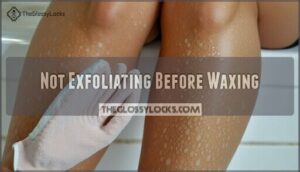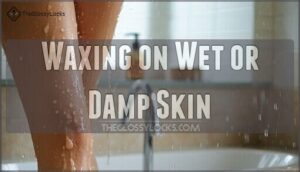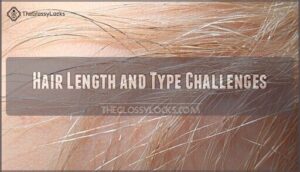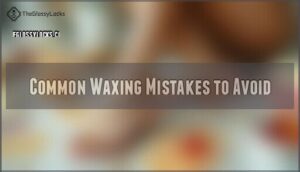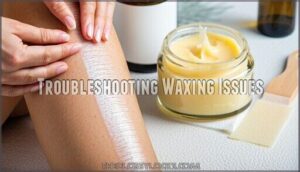This site is supported by our readers. We may earn a commission, at no cost to you, if you purchase through links.
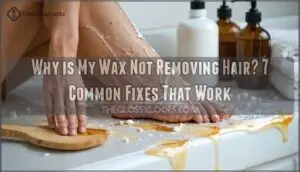
Maybe your wax isn’t hot enough, or it’s spread too thin. Sometimes, wax just doesn’t grab short or long hair well, or you pulled the strip in the wrong direction.
Not prepping your skin—like skipping exfoliation or applying to damp skin—can also trip things up. Everyone slips up now and then, but with a few simple shifts in your routine, you’ll be back on track in no time.
Up next: smart fixes and pro tricks.
Table Of Contents
- Key Takeaways
- Wax Preparation Issues
- Incorrect Wax Application Techniques
- Skin Preparation Mistakes
- Hair Length and Type Challenges
- Wax Removal Problems
- Common Waxing Mistakes to Avoid
- Troubleshooting Waxing Issues
- Frequently Asked Questions (FAQs)
- Why is my wax not pulling out hair?
- Why am I still seeing Hair after waxing?
- How do I avoid hairy hair when waxing?
- Why is my hair strays left over during waxing?
- Why is my wax strip breaking?
- What happens if I don’t pull enough hard wax?
- Why is my hard wax not removing all the hair?
- What are the effects of excessive hair washing on hair growth?
- Why is my wax not sticking to my hair?
- Why isn’t my hair coming off when waxing?
- Conclusion
Key Takeaways
- Make sure your wax is hot enough and has a smooth, honey-like consistency before applying.
- Always prep your skin by cleansing, exfoliating, and drying it thoroughly for better wax grip.
- Apply wax in the direction of hair growth and pull it off quickly against the grain while holding your skin taut.
- Don’t forget that hair length matters—stick to a quarter to half inch for best results and trim longer hair before waxing.
Wax Preparation Issues
If your wax isn’t removing hair, preparation issues like incorrect heating, bad consistency, or low-quality wax may be to blame.
Paying attention to these details can make all the difference in how well your waxing turns out.
Insufficient Heating of Wax
When your wax isn’t removing hair, odds are the wax temperature is too low.
If your wax isn’t removing hair, chances are it simply needs a little more heat for real results.
Uneven heating—often from skipping a temperature gauge or relying on an old wax warmer—means your wax can’t reach the “liquid honey” consistency you need for proper grip.
If your wax isn’t spreading smoothly or just isn’t grabbing hair, that’s a major sign you need more heat.
You may need to examine consistent warmer settings for ideal results.
Try the wrist test: dab a little on your wrist to check if it feels warm (not hot) and flows easily.
Proper waxing troubleshooting starts here—without enough heat, wax won’t stick, and you’re left repeating passes.
Always double-check wax temperature before starting.
Incorrect Wax Consistency
Getting the right wax consistency is like finding that sweet spot between syrup and putty—too runny or too thick, and wax not grabbing hair becomes the norm.
Watch for a texture like warm honey. Overheated wax gets too liquid, underheated wax turns stubborn.
For stress-free waxing troubleshooting, remember:
- Drippy or thick blobs
- Soft Sugar Wax
- Inconsistent Wax Temperature
- Hard, sticky messes
This will help you achieve the perfect wax consistency and avoid common issues, ensuring a successful waxing experience with warm honey texture and avoiding an inconsistent temperature.
Using Low-Quality Wax
Don’t let low-quality wax turn your session into a sticky situation.
When wax not removing hair is the norm, you’re probably facing adhesion problems, residue leftover, skin irritation, and ineffective removal. Skimping leads to costly alternatives—redoing the job or treating your skin.
Stick to reputable wax brands for better wax adhesion, waxing effectiveness, and smoother results. Many users find success using top wax products.
Wax adhesion
Sticky skin surprises
Hair removal effectiveness
Incorrect Wax Application Techniques
If your wax isn’t removing hair, you’re probably making common application mistakes. Getting the layer thickness, direction, and pressure right is essential for smooth results.
Applying Too Thin or Too Thick a Layer
Moving on from poor wax prep, an uneven application is a common waxing issue.
Too-thin layers lead to ineffective adhesion and missed hairs, while going too thick traps hair but also leaves residue and bruising potential.
Avoid this wax application error by mastering the right wax thickness.
Here’s how to fix this waxing common issue:
- Spread wax evenly.
- Watch wax thickness.
- Check for smooth coverage.
This will help ensure effective adhesion and prevent issues like missed hairs and bruising potential, ultimately leading to a better waxing experience with smooth coverage.
Not Following The Direction of Hair Growth
If your wax isn’t grabbing hair, it might be time to check your Growth Pattern Awareness.
Application Angle Matters more than you’d think. Always smooth wax in the direction of hair growth, then remove it quickly against it.
Ignoring Removal Directionality causes waxing not working, more pain, and ingrown hair.
Correct hair growth direction cuts down on waxing common issues, which is why Application Angle is crucial.
Not Applying Enough Pressure
Imagine this scenario: you’re pressing a sticker onto a surface—if you skip the pressure, it comes right off.
Just like a sticker, only steady pressure ensures your wax sticks for smooth, successful hair removal every time.
The same goes for waxing. Skipping firm pressure leads to Adhesion Failure, Wax Slippage, and Incomplete Removal.
Give extra focus to Pressure Points for better Technique Refinement. If waxing isn’t working, apply steady pressure so wax won’t grab hair weakly.
Skin Preparation Mistakes
If your wax isn’t gripping hair, chances are your skin prep routine needs some work. Clean, exfoliated, and dry skin is essential for a smooth, effective waxing session.
Not Cleansing The Skin Properly
If you skip proper skin preparation, your waxing results might suffer.
Oil residue, leftover makeup buildup, or sweat interference can all act as product barriers, preventing wax from grabbing those stubborn hairs.
Grab a gentle prewax cleanser—don’t just rely on last night’s face wash.
Even a quick swipe with proper cleansing methods can make or break your smooth skin goals.
Not Exfoliating Before Waxing
Before waxing, not exfoliating can leave you stuck with stubborn dead skin buildup and hair that just won’t budge.
Exfoliation timing is key—aim for 1-2 days before waxing to prep your skin for easier hair removal and fewer ingrown hairs.
Want better results? Try these go-to tools for circulation improvement and smoother waxing preparation:
- Fresh, prepped skin boosts waxing power.
- Exfoliation prevents pesky ingrown hairs.
- The right tools make all the difference—try a sugar scrub or exfoliating glove for best results.
For ideal skin preparation, consider using an exfoliating glove product.
Waxing on Wet or Damp Skin
Right after a shower, your skin feels fresh, but moisture spells trouble for waxing.
Hydration impact is real—it leads to adhesion failure since wet skin keeps wax from sticking, leaving hair still there after wax.
Dampness also boosts bacteria risk and skin irritation.
Always dry off thoroughly; otherwise, you’ll deal with ineffective removal, wax not grabbing hair, and lasting waxing issues.
Hair Length and Type Challenges
If your wax isn’t grabbing every hair, the length and type might be making things tricky.
Understanding what works best for your hair’s texture and length can help you get smoother results every time.
Hair Too Short or Too Long for Waxing
Not all hair lengths are equal in the context of waxing.
Aim for the Ideal Hair Length—about 1/4 to 1/2 inch—to avoid the classic “wax won’t grab hair” problem.
Going longer? Trimming Before Waxing keeps pain and Hair Breakage low.
Too short, and you’ll battle stray hairs.
Stick to a steady Waxing Schedule for smoother results.
Dealing With Coarse or Fine Hair
Hitting the right length is important, but hair thickness poses its own challenge.
Coarse hair removal needs hard wax and a steady hand, while fine hair adhesion works best with soft wax.
Wax type matters, and so does keeping an eye on hair growth direction.
For coarse hair, understanding hair porosity is key to proper treatment.
Pay attention to skin sensitivity for every hair type and texture.
- Coarse Hair Removal: Hard wax wins.
- Fine Hair Adhesion: Soft wax, thin layer.
- Wax Type Matters for best results.
- Always follow Hair Growth Direction.
- Adjust for Skin Sensitivity.
Adapting to Different Hair Textures
Finding your groove with waxing means matching your method to your hair type—no one-size-fits-all here.
Coarse hair benefits from hard wax and good, firm pressure for real grip, while fine hair needs a gentler touch and soft wax for less skin stress.
For curly hair, sugar wax works well when you focus on the growth patterns.
Straight strands? Fruit wax and basic technique usually do the trick.
Check out the quick guide below to tailor your plan:
| Hair Texture | Best Wax Type | Application Tip |
|---|---|---|
| Coarse Hair | Hard Wax | Firm, even pressure |
| Fine Hair | Soft Wax | Gentle, thin layer |
| Curly | Sugar Wax | Follow hair pattern |
| Straight | Fruit Wax | Consistent spread |
Wax Removal Problems
If your wax isn’t removing hair, the problem might be in how you’re taking it off.
The right speed, direction, and tension during removal all make a real difference in getting smooth results.
Removing The Wax Too Quickly or Too Slowly
Removal timing is key—move too fast, and you risk pain and wax not sticking. Too slow, and you’ll face wax failing and ineffective waxing.
Here are five ways to nail your speed:
- Watch your speed.
- Use swift, confident pulls.
- Time your wax removal.
- Refine your technique.
- Prioritize smooth hair extraction, which involves swift and confident actions to ensure effective waxing.
Not Pulling in The Right Direction
If your wax won’t grab hair or you’re facing ineffective waxing, pay attention to Removal Direction Matters.
Pulling the strip the wrong way leaves stubble and bumps while wax failing means you can’t remove hair with wax, period.
Master the Swift Pull Technique with the right angle for best results.
| Mistake | Result |
|---|---|
| Wrong direction | Wax not sticking |
| Right direction | Fewer repeat tries |
| Awkward angle | Patchy removal |
| Hair Growth Patterns | Smoother outcome |
The table outlines the importance of direction and angle in waxing, highlighting the consequences of incorrect techniques, such as Patchy removal, and the benefits of correct methods, leading to a Smoother outcome.
Not Holding The Skin Taut
Ever wonder why your wax won’t grab hair or you just can’t remove hair with wax—no matter how hard you try?
Not holding the skin taut is a common culprit. Stretching the skin tight before removing the strip improves wax adhesion, helps with pain reduction, minimizes bruising, and guarantees better hair extraction.
It’s a simple waxing technique refinement that works. Ripped skin can occur, so immediate post-wax care is essential.
Common Waxing Mistakes to Avoid
You might be surprised how often simple mistakes can make waxing less effective. By knowing what to avoid, you’ll save time, minimize discomfort, and get better results every time.
Not Preparing The Skin Correctly
Results get patchy when skin’s not prepped for wax.
Even if your removal technique is sharp, skipping cleansing importance, exfoliation timing, or using pre-wax products sets you back.
Any leftover residue or moisture blocks grip—skin dryness is key.
Try oil-absorbing powders, and focus on thorough residue removal.
Follow waxing preparation recommendations for smoother, longer-lasting results.
Not Using The Right Type of Wax
You can scrub and prep your skin, but if your wax type doesn’t match your needs, results fall flat.
Hard wax works better on sensitive areas and thick hair, while soft wax handles larger zones.
Double-check wax compatibility—ingredients matter, especially with skin reactions.
Using the wrong wax, or trying on hair too short for wax, often leaves stubble behind, and sensitive areas can be particularly problematic, so double-check your wax choice to ensure the best results.
Not Following Proper After-Wax Care
Handle your afterwax care like a pro for smooth skin and fewer problems.
Redness and irritation aren’t badges of honor—avoid them by following a few basics.
- Skip the hot bath and sun exposure to minimize flare-ups.
- Pass on tight clothes to let your skin breathe.
- Hold off on makeup, deodorant, and perfumed lotions.
- Moisturize gently, but don’t exfoliate or cleanse harshly right away.
If wax gets on clothing, remember you can try scraping off hardened wax.
Troubleshooting Waxing Issues
If your wax isn’t removing hair the way you expect, you’re not alone—several small issues can cause less-than-smooth results.
Let’s walk through the most common fixes so you can get back to effective, hassle-free waxing.
What to Do if Wax Won’t Come Off
Wax stuck to your skin? Grab one of these simple tricks for residue removal. Start with a warm compress, holding it over the area for about a minute—helps soften stubborn wax.
If that doesn’t do the trick, massage a bit of mineral or olive oil for two minutes; it’ll dissolve even the toughest stuck wax. For cooling issues, an ice cube for thirty seconds can make wax brittle, so it peels away cleanly.
Remember, wax removal problems often come from choosing the wrong wax type, poor application, or wax temperature too low—adjust your technique if you can’t remove hair with wax. This includes considering the right wax type and ensuring the wax temperature is appropriate.
How to Handle Ingrown Hairs or Breakouts
Done with sticky wax? Next up: the stubborn guests—ingrown hairs and breakouts. Want to keep them in check? Start by exfoliating gently and using an ingrown hair serum to help unclog those pesky follicles.
Moisturize with aloe for Soothing Irritation. And always reach for loose clothes, letting your skin breathe after waxing.
Shaving cream helps by reducing friction and irritation, preventing ingrown hairs.
Here’s a simple plan:
- Exfoliation Methods before waxing
- Post-Wax Care with soothing gels
- Preventing Ingrowns and Treating Breakouts by staying clean and comfortable
Adjusting Your Waxing Technique for Better Results
A few tweaks to your waxing technique can make all the difference. Keep your Wax application angle low as you spread, use steady Pressure application, and test on a small patch to see what works.
Strip removal speed matters—pull fast, not slow, to get a clean finish. Always keep Skin tautness in mind.
Practice these waxing techniques and patch testing to avoid situations where wax won’t grab hair or you just can’t remove hair with wax.
- Quick, confident strip removal
- Smooth skin that lasts
- Mastery of proper wax application techniques
Frequently Asked Questions (FAQs)
Why is my wax not pulling out hair?
You’re not getting results because the wax might be too cool, too thick, or applied the wrong way.
Check that your skin is clean and dry, and always pull quickly in the opposite direction of hair growth.
Why am I still seeing Hair after waxing?
You’re spotting hairs after waxing because they’re often too short, wax isn’t heated enough, or skin wasn’t prepped right.
Some hairs might break, not pull out by the root, or simply slip past the wax’s grip.
How do I avoid hairy hair when waxing?
Always exfoliate before waxing, make sure your hair is at least a quarter-inch long, and clean, dry your skin.
Apply wax in the direction of hair growth, pull off quickly against it, and hold skin taut.
Why is my hair strays left over during waxing?
Stray hairs sticking around after waxing usually means the wax didn’t grab them properly.
This happens if the hair’s too short, the wax went on too thick or thin, or your skin wasn’t clean and dry before waxing, which can be considered a complete issue related to the waxing process itself.
Why is my wax strip breaking?
It feels like your wax strip breaks faster than a brittle toothpick, right?
Usually, pulling wax off before it cools or applying it too thin is the culprit.
Wait for a dull finish, then yank with confidence.
What happens if I don’t pull enough hard wax?
If you don’t pull hard wax firmly enough, it won’t grip and lift the hair out from the root.
Instead, you’ll end up with patchy results, some leftover wax, and possibly more pain than success.
Why is my hard wax not removing all the hair?
Sometimes, it’s like your wax is trying to catch fish with a torn net.
If the wax’s too cool, thin, or removed too soon, it won’t grip hair well.
Make sure it fully hardens before yanking.
What are the effects of excessive hair washing on hair growth?
Washing your hair too often can strip away natural oils, leaving your scalp dry and hair brittle.
This doesn’t cause hair loss directly, but it can weaken strands and make them more likely to break or split.
Why is my wax not sticking to my hair?
Hot wax clings like honey, but if your skin’s oily or damp, it slips right off.
Missed a spot cleansing or left moisturizer? The wax can’t grip.
Always clean and dry your skin before starting, as clean skin is essential for the wax to adhere properly.
Why isn’t my hair coming off when waxing?
Your hair mightn’t budge during waxing if it’s too short, the wax isn’t hot enough, or your skin isn’t prepped well.
Check that the wax grabs evenly, your skin’s clean and dry, and your technique’s solid.
Conclusion
Just like finding the right key for a stubborn lock, understanding why your wax isn’t removing hair takes a bit of troubleshooting.
By tuning in to details like wax temperature, technique, and skin prep, you can steer clear of common mistakes.
If you still wonder, “why is my wax not removing hair,” review each step and tweak your routine.
Patience and the right approach make all the difference for smoother, longer-lasting results.
Consistency truly pays off.


